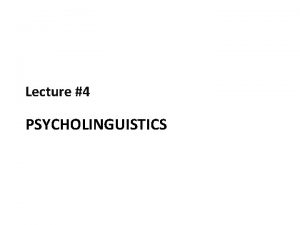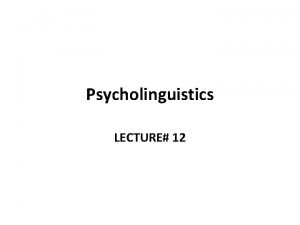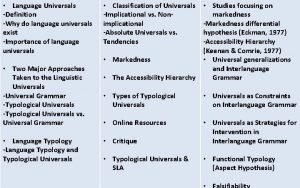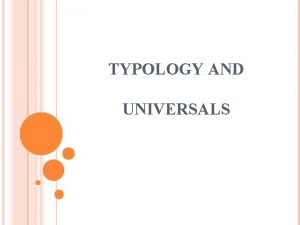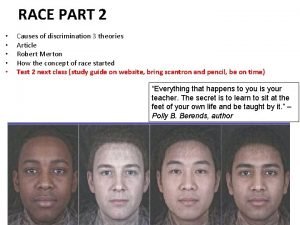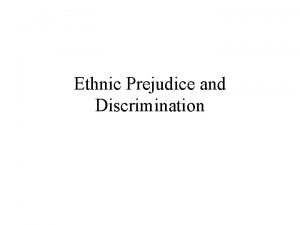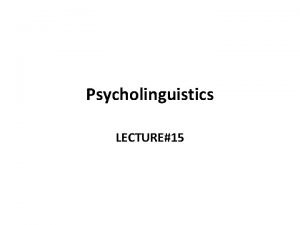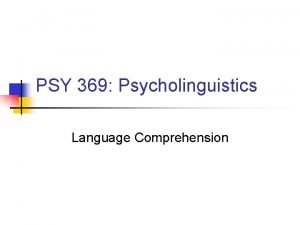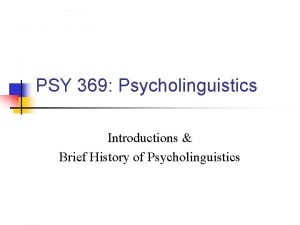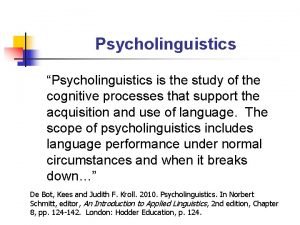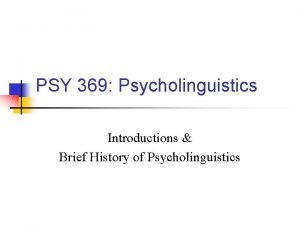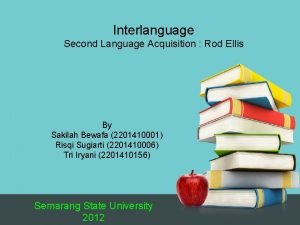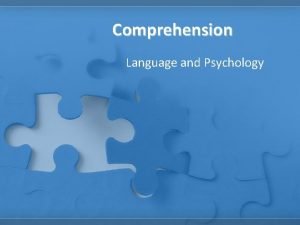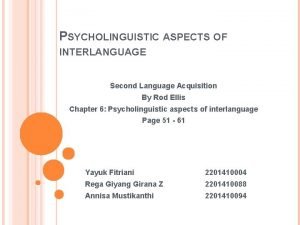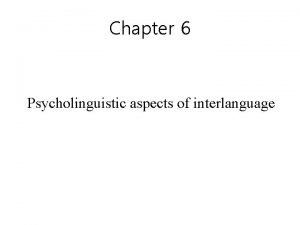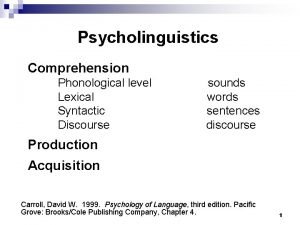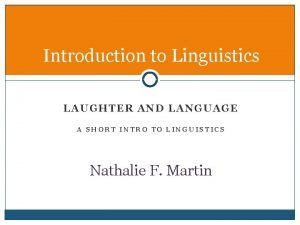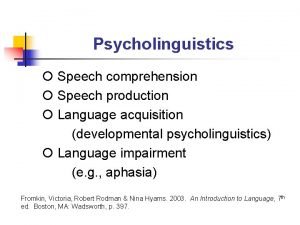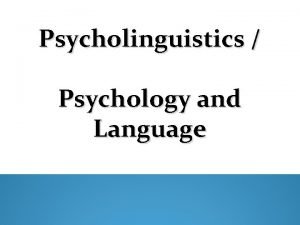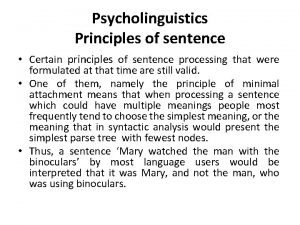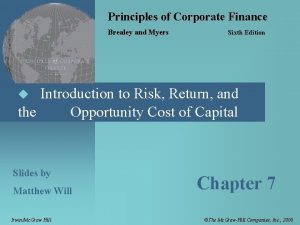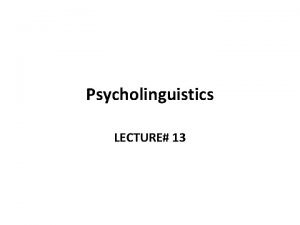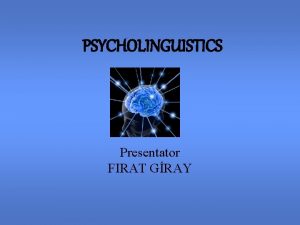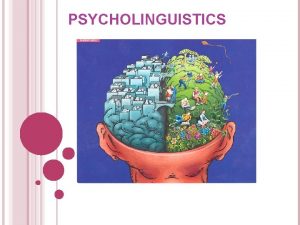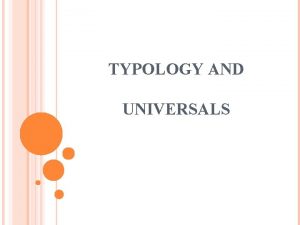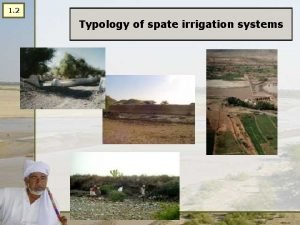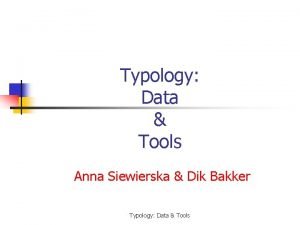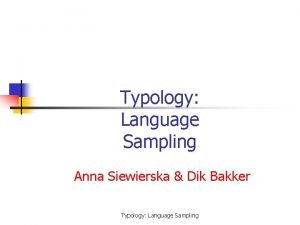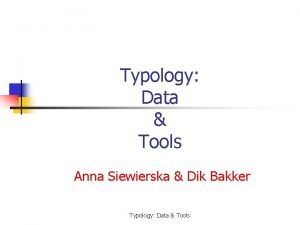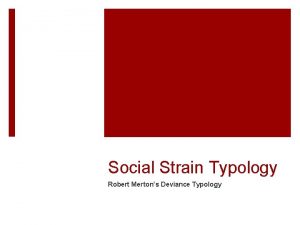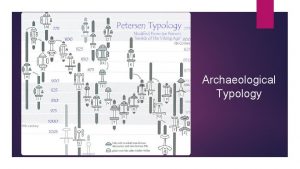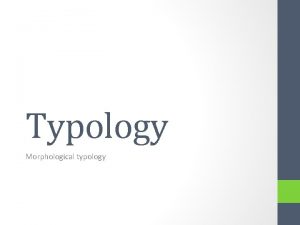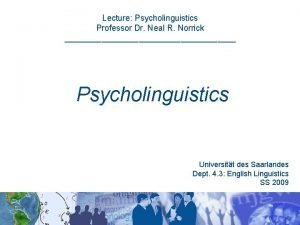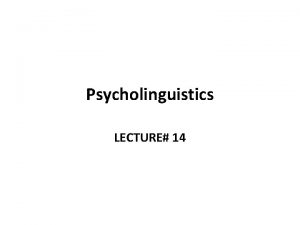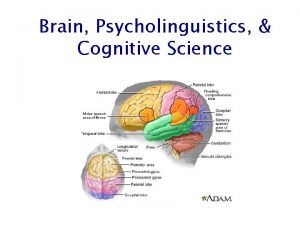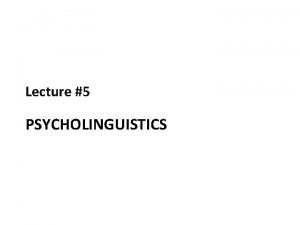LINGUISTIC TYPOLOGY AND CROSSLINGUISTIC PSYCHOLINGUISTICS James Myers Graduate



























- Slides: 27

LINGUISTIC TYPOLOGY AND CROSS-LINGUISTIC PSYCHOLINGUISTICS James Myers Graduate Institute of Linguistics National Chung Cheng University Taiwan Tsung-ying Chen Dept. of Foreign Languages & Literature National Tsinghua University Taiwan 50 th Annual Meeting of the Societas Linguistica Europaea, Zürich 12 Sept 2017

Welcome to our workshop! 2

OVERVIEW Why do typological psycholinguistics? To see how language experience affects learning and processing, and thus. . . . to seek out and explain linguistic universals Two methodological approaches Empiricist: Induce universals from large samples Rationalist: Deduce universals from learnability Expanding the typology 3

TYPOLOGY AND PSYCHOLINGUISTICS Typologists E. g. are doing more experiments Bickel et al. (2015) Psycholinguists E. g. , Both are doing more typology Norcliffe et al. (2015) could learn more from each other Experiments to test processing-based explanations for language universals Experiments on a wider variety of languages to test hypothesized processing universals These goals cannot be achieved in isolation! 4

UNIVERSAL PROCESSING MODELS? O'Seaghdha et al. (2010), modifying Levelt et al. (1999) 5

OR UNIVERSAL LEARNING MODELS? Chinese experience Universal learning algorithm English experience 6

TESTING UNIVERSALS Rationalist/deductive approach Chomsky (1965): Learners need universals So assume all is universal unless shown otherwise Empiricist/inductive approach Greenberg (1963): Languages vary in limited ways So study the typology of cross-linguistic variation What about psycholinguists? Empiricists when studying individual languages But rationalists when making universal claims 7

A TYPICAL PSYCHOLINGUISTIC STUDY 8

A TYPICAL CROSS-LINGUISTIC STUDY 9

TWO LANGUAGES DON’T MAKE TYPOLOGY Two-language studies imply a factorial design But cross-linguistic variables are confounded English vs. Chinese orthography (ABC vs. 字) English vs. Chinese homophones (few vs. many) Some variables are also gradient Number of homophones: few, more, many, . . . Additional variables keep getting discovered English vs. Chinese relative clauses: N-RC vs. RC-N . . . but also many language-specific factors (Lin, 2017) 10

THE ROLE OF EMPIRICISM/INDUCTION Lexical researchers know these problems well Participants come into lab knowing their lexicon Words Lexical cannot be experimentally manipulated variables are also gradient & confounded Gradience: Frequency, length, . . . Confounding: High-frequency words are shorter Designing factorial lexical experiments is thus a “confounded nuisance” (Cutler, 1981) A recently popular solution: megastudies Regression analyses on large, diverse data sets 11

THE MEGASTUDY MOVEMENT The English Lexicon Project (Balota et al. 2007) 1000 s of visual lexical decisions and naming responses for 1000 s of written English words and non-words: http: //elexicon. wustl. edu/ Similar projects in Dutch, French, Chinese, Malay (Balota et al. 2012; Keuleers & Balota 2015) Also auditory lexical decision, priming, picture naming, . . . http: //crr. ugent. be/emlar 2015/list%20 of%20%20 lexical%20 databases. html 12

SO HOW ABOUT META-MEGASTUDIES. . . ? Myers (2016) Generalizing megastudy logic cross-linguistically Behavior in task (a black box) Response Language experience Lang uage varia -level bles vel e l Item bles a vari Experimental task 13

SAMPLING LANGUAGES FOR GRAMMAR (e. g. , Cysouw, 2005) Universal principle “Natural” Type A Type B Borrowing Lang Learning from speech community hides natural patterns Lang Descent 14

SAMPLING LANGUAGES FOR PROCESSES Language experience “Natural” Borrowing & descent can only bias up here Universal learning algorithm Process A Lang Process B Lang Processing ignores (? ) community conventions 15

DIVERSITY > REPRESENTATIVENESS For psycholinguistics, language samples only need to deconfound processing-related variables Borrowing and descent unlikely to affect processing independently of the typological features themselves “Small” Only Partial Even samples OK (e. g. , Vittinghoff & Mc. Culloch, 2007) need around 10 x number of variables confounds OK (e. g. , O’Brien, 2007) with r 2 =. 9 or higher 16

LANGUAGE SAMPLES IN TODAY’S TALKS Dressler et al. Chen & Myers White et al. Namboodiripad Culbertson & Braquet Dimitriadis et al. Sauppe et al. Blumenthal-Dramé & Kortmann Bulgarian Cantonese Danish Dutch English Estonian Finnish French German Greek Hindi Hungarian Italian Korean Lithuanian Malayalam Mandarin Russian Saami Spanish Turkish 17

THE ROLE OF RATIONALISM/DEDUCTION If learners need universals, then why not study universals by looking at learners? Natural language learning Children are biased (e. g. , Lidz & Gagliardi, 2015) Adults treat “natural” and “unnatural” patterns within their own language differently (e. g. , Hayes et al. , 2009) Artificial grammar learning Simulates second language learning, allowing for controlled tests of learning biases (Culbertson, 2012) 18

LEARNING IN TODAY’S TALKS Natural first language acquisition by children Dressler et al. Artificial language learning by adults Culbertson & Braquet Dimitriadis et al. White et al. Presumed effects of first language on adults Blumenthal-Dramé & Kortmann Chen & Myers Namboodiripad Sauppe et al. 19

ARTIFICIAL GRAMMAR LEARNING Language A experience Language B experience Universal learning algorithm Learning succeeds Learning fails 20

ARTIFICIAL LEARNING IN CONTEXT English experience Universal learning algorithm Chinese experience English-modulated learning algorithm Lang. A Chinese-modulated learning algorithm A>B Lang. B A>B 21

HOW TO EXPAND THE TYPOLOGY? Make lots of friends. . . Bates . . . et al. (2003): 7 languages, 22 authors and/or emulate the typological grammarians Thousands of independent scholars collect data on specific languages for their own purposes. . . . and then a relatively small number of typologists compile databases (e. g. , Haspelmath et al. , 2005) Could psycholinguistics be done this way too. . . ? 22

THE REST OF TODAY’S SCHEDULE Time Authors Domain Method 9: 30 -9: 55 Dimitriadis & al. Morphology Artificial grammar 11: 30 -11: 55 Culbertson & Braquet Syntax Artificial grammar 12: 00 -12: 25 White & al. Phonology Artificial grammar 12: 30 -13: 00 Namboodiripad Syntax Acceptability 16: 00 -16: 25 Chen & Myers Phonology Acceptability 16: 30 -16: 55 Dressler & al. Morphology Corpus analysis 17: 30 -17: 55 Blumenthal-Dramé & Kortmann Syntax Comprehension 18: 00 -18: 25 Sauppe & al. Syntax Production 18: 30 -18: 55 Discussion 23

REFERENCES (1/4) Adelman et al. (2014). A behavioral database for masked form priming. Behavior Research Methods, 46 (4). Balota et al. (2007). The English Lexicon Project. Beh. Res. Meth. , 39. Balota et al. (2012). Megastudies: What do millions (or so) of trials tell us about lexical processing? In Adelman (Ed). Visual word recognition, Vol. 1. Psychology Press. Bates et al. (2003). Timed picture naming in seven languages. Psychonomic Bulletin & Review, 10 (2). Bickel et al. (2015). The neurophysiology of language processing shapes the evolution of grammar: Evidence from case marking. PLo. S ONE, 10(8). Chomsky (1965). Aspects of theory of syntax. MIT Press. Culbertson (2012). Typological universals as reflections of biased learning: Evidence from artificial language learning. Language & Linguistics Compass, 6. 24

REFERENCES (2/4) Cutler (1981). Making up materials is a confounded nuisance, or: Will we be able to run any psycholinguistic experiments at all in 1990? Cognition, 10. Cysouw (2005). Quantitative methods in typology. In Kohler et al. (Eds. ) Quantitative linguistics: An international handbook. Walter de Gruyter. Feng et al. (2001). Rowed to recovery: The use of phonological and orthographic information in reading Chinese and English. J. of Experimental Psychology: Learning, Memory and Cognition, 27 (4). Greenberg (1963). Some universals of grammar with particular reference to the order of meaningful elements. In Greenberg (Ed. ) Universals of language. MIT Press. Haspelmath et al. (Eds. ) (2005). The world atlas of language structure. Oxford University Press. 25

REFERENCES (3/4) Hayes et al. . (2009). Natural and unnatural constraints in Hungarian vowel harmony. Language, 85(4). Keuleers & Balota (2015). Megastudies, crowdsourcing, and large datasets in psycholinguistics: An overview of recent developments. Quarterly Journal of Experimental Psychology, 68 (8). Levelt et al. (1999). A theory of lexical access in speech production. Behavioral and Brain Sciences, 22 (1). Lidz & Gagliardi (2015). How nature meets nurture: Universal grammar and statistical learning. Annual Review of Linguistics, 1(1). Lin (2017). Sentence processing: Relative clauses. In R. Sybesma et al. (Eds. ), Encyclopedia of Chinese language and linguistics, vol. 3. Brill. Myers (2016). Meta-megastudies. The Mental Lexicon, 11(3). 26

REFERENCES (4/4) Norcliffe et al. (2015). Cross-linguistic psycholinguistics and its critical role in theory development: Early beginnings and recent advances. Language, Cognition and Neuroscience, 30(9). O’Brien. (2007). A caution regarding rules of thumb for Variance Inflation Factors. Quality & Quantity, 41. O’Seaghdha et al. (2010). Proximate units in word production: Phonological encoding begins with syllables in Mandarin Chinese but with segments in English. Cognition, 115. Vittinghoff & Mc. Culloch (2007). Relaxing the rule of ten events per variable in logistic and Cox regression. American Journal of Epidemiology, 165 (6). 27
 Psycholinguistics definition and examples
Psycholinguistics definition and examples Psycholinguistics definition and scope
Psycholinguistics definition and scope Scsi unit fbi
Scsi unit fbi James russell odom and james clayton lawson
James russell odom and james clayton lawson Word combinations
Word combinations Absolute universals
Absolute universals Typology and universals
Typology and universals Www pearltrees com
Www pearltrees com Dyer and holder typology of strategies
Dyer and holder typology of strategies Merton's typology of prejudice and discrimination
Merton's typology of prejudice and discrimination Merton's typology of prejudice and discrimination
Merton's typology of prejudice and discrimination What is psycholinguistics
What is psycholinguistics Language loss in psycholinguistics
Language loss in psycholinguistics Puldow cross
Puldow cross History of psycholinguistics
History of psycholinguistics Psycholinguistics
Psycholinguistics History of psycholinguistics
History of psycholinguistics Rod ellis
Rod ellis Derivational theory of complexity
Derivational theory of complexity Psycholinguistic approach to second language acquisition
Psycholinguistic approach to second language acquisition Psychological aspects of interlanguage
Psychological aspects of interlanguage Comprehension of words in psycholinguistics
Comprehension of words in psycholinguistics Language a
Language a Language comprehension in psycholinguistics
Language comprehension in psycholinguistics Psycholinguistics psychology definition
Psycholinguistics psychology definition What is the scope of psycholinguistics
What is the scope of psycholinguistics Scope of psycholinguistics
Scope of psycholinguistics Finance brealey and myers
Finance brealey and myers
